History of Romania
Prehistory[edit]
34,950-year-old remains of modern humans with a possible Neanderthalian trait were discovered in present-day Romania when the Peștera cu Oase ("Cave with Bones") was uncovered in 2002.[1] In 2011, older modern human remains were identified in the UK (Kents Cavern 41,500 to 44,200 years old) and Italy (Grotta del Cavallo 43,000 to 45,000 years old)[2] but the Romanian fossils are still among the oldest remains of Homo sapiens in Europe, so they may be representative of the first such people to have entered Europe.[3] The remains present a mixture of archaic, early modern human and Neanderthal morphological features.[4][5][6] [7]
The Neolithic-Age Cucuteni area in northeastern Romania was the western region of the earliest European civilization, which is known as the Cucuteni–Trypillia culture.[8] The earliest-known salt works is at Poiana Slatinei near the village of Lunca; it was first used in the early Neolithic around 6050 BC by the Starčevo culture and later by the Cucuteni-Trypillia culture in the pre-Cucuteni period.[9] Evidence from this and other sites indicates the Cucuteni-Trypillia culture extracted salt from salt-laden spring water through the process of briquetage.[citation needed]
Dacia[edit]
The earliest written evidence of people living in the territory of present-day Romania comes from Herodotus in Book IV of his Histories, which was written in c. 440 BC; He writes that the tribal confederation of the Getae were defeated by the Persian Emperor Darius the Great during his campaign against the Scythians.[10] The Dacians, who are widely accepted as part of the Getae described earlier by the Greeks, were a branch of Thracians who inhabited Dacia, which corresponds with modern Romania, Moldova, northern Bulgaria and surrounding nations.[11]
The Dacian Kingdom reached its maximum expansion during the reign of King Burebista between 82 BC and 44 BC. Under his leadership, Dacia became a powerful state that threatened the regional interests of the Romans. Julius Caesar intended to start a campaign against the Dacians due to the support that Burebista gave to Pompey but he was assassinated in 44 BC.[citation needed] A few months later, Burebista was assassinated by his own noblemen. Another theory suggests he was killed by Caesar's friends. Burebista's powerful state was divided into four and was not reunified until 95 AD under the reign of the Dacian king Decebalus.[citation needed]
The Roman Empire conquered Moesia by 29 BC, reaching the Danube River. In 87 AD, Emperor Domitian sent six legions into Dacia, which were defeated at Tapae. The Dacians were eventually defeated by Emperor Trajan in two campaigns that lasted from 101 AD to 106 AD,[12] and the core of their kingdom was turned into the province of Roman Dacia.
Roman Dacia (106–275 AD)[edit]
The Romans exploited the rich ore deposits of Dacia. Gold and silver were especially plentiful,[13] and were found in great quantities in the Western Carpathians. After Trajan's conquest, he took to Rome over 165 tons of gold and 330 tons of silver. The Romans colonized the province extensively,[14] beginning a period of intense romanization, during which the language Vulgar Latin morphed into the Proto-Romanian language.[15][16]
Dacia's geographical position made it difficult to defend against the barbarians and during 240–256 AD, Dacia was lost under attacks of the Carpi and the Goths. The Roman Empire withdrew from Dacia Romana around 271 AD, making it the first province to be abandoned.[17][18]
Early Middle Ages[edit]
Between 271 and 275, the Roman army and administration left Dacia, which was invaded later by the Goths.[19] The Goths mixed with the local people until the 4th century, when the Huns, a nomadic people, arrived.[20] The Gepids,[21][22] the Avars, the Bulgars and their Slavic subjects[23] ruled Transylvania until the 8th century. The territories of Wallachia and Moldavia were under the control of the First Bulgarian Empire from its establishment in 681 until around the time of the Hungarian conquest of Transylvania at the end of the 10th century.[21]
After the disintegration of Great Bulgaria following Khan Kubrat's death in 668, a large group of Bulgars followed Asparukh, the third son of the great Khan, who headed westwards. In the 670's they settled in the area known as the Ongal to the north of the Danube delta.[citation needed] From there, Asparukh's cavalry in alliance with local Slavs annually attacked the Byzantine territories in the south. In 680, the Byzantine Emperor Constantine IV led a large army to fight the Bulgars but was defeated in the battle of Ongal and the Byzantines were forced to acknowledge the formation of a new country, the First Bulgarian Empire. The northern border of the country followed the southern slopes of the Carpathian mountains from the Iron Gates and reached the Dneper river or possibly just the Dniester river to the east.[citation needed]
The Bulgarians' main rivals in the area were the Avars to the west and the Khazars to the east. The Khazars were a serious threat; they marched westwards after they crushed the resistance of Kubrat's eldest son Bayan and waged a war against Asparukh, who perished in battle in 700.[citation needed] To protect their northern borders, the Bulgarians built several enormous ditches that ran the whole length of the border from the Timok river to the Black Sea.[citation needed]
In 803, Krum of Bulgaria became Khan. The new, energetic ruler focused on the north-west where Bulgaria's old enemies the Avars experienced difficulties and setbacks against the Franks under Charlemagne.[citation needed] Between 804 and 806, the Bulgarian armies annihilated the Avars and destroyed their state. Krum took the eastern parts of the former Avar Khaganate and took over rule of the local Slavic tribes. Bulgaria's territory twice extended twice from the middle Danube to the north of Budapest to the Dnester, though its possession of Transylvania is debatable.[citation needed] In 813 Khan Krum seized Odrin and plundered the whole of Eastern Thrace. He took 50,000 captives who were settled in Bulgaria across the Danube.[citation needed]
The Pechenegs,[24] the Cumans[25] and Uzes are also mentioned by historic chronicles on the territory of Romania until the founding of the Romanian principalities of Wallachia in the south by Basarab I around 1310 in the High Middle Ages,[26] and Moldavia in the east, by Dragoş around 1352.[27]
High Middle Ages[edit]
The Pechenegs, a semi-nomadic Turkic people of the Central Asian steppes, occupied the steppes north of the Black Sea from the 8th to the 12th centuries, and by the 10th century they were in control of all of the territory between the Don and the lower Danube rivers.[28] During the 11th and 12th centuries, the nomadic confederacy of the Cumans and Eastern Kipchaks dominated the territories between present-day Kazakhstan, southern Russia, Ukraine, southern Moldavia and western Wallachia.[29][30][31][32]
It is a subject of dispute whether elements of the mixed Daco–Roman population survived in Transylvania through the Dark Ages to become the ancestors of modern Romanians or whether the first Vlachs and Romanians appeared in the area in the 13th century after a northward migration from the Balkan Peninsula.[33][34] There is also debate over the ethnicity of Transylvania's population before the Hungarian conquest.[citation needed]
There is evidence the Second Bulgarian Empire, at least nominally, ruled the Wallachian lands up to the Rucăr–Bran corridor until the late 14th century. In a charter by Radu I, the Wallachian voivode requests tsar Ivan Alexander of Bulgaria to order his customs officers at Rucăr and the Dâmboviţa River bridge to collect taxes following the law. The presence of Bulgarian customs officers at the Carpathians indicates Bulgarian suzerainty over those lands, though Radu's imperative tone implies a strong and increasing Wallachian autonomy.[35] Under Radu I and his successor Dan I, the realms in Transylvania and Severin[disambiguation needed] continued to be disputed with Hungary.[36] Basarab was succeeded by Nicholas Alexander and Vladislav I. Vladislav attacked Transylvania after Louis I occupied lands south of the Danube, conceded to recognize him as overlord in 1368 but rebelled again in the same year. Vladislav's rule also witnessed the first confrontation between Wallachia and the Ottoman Empire, a battle in which Vladislav was allied with Ivan Shishman.[37] After the Magyar conquest of the 10th and 11th centuries, Transylvania became an autonomous and multi-ethnic voivodeship that was led by a voivode who was appointed by the King of Hungary until the 16th century.[38]
Several Kings of Hungary invited settlers from Central and Western Europe, such as the Saxons, to occupy Transylvania. The Székelys were brought to southeastern Transylvania as border guards. Romanians are mentioned by the Hungarian documents of a township called Olahteluk in 1283 in Bihar County.[39][40] The "land of Romanians" (Terram Blacorum)[41][42][43][40] appeared in Făgăraş and this area was mentioned under the name "Olachi" in 1285.[40] After the collapse of the Hungarian Kingdom following the disastrous Battle of Mohács in 1526, the region became the independent Principality of Transylvania[44] until 1711.[45]
Many other small states with varying degrees of independence developed on the territory of today's Romania.[citation needed] In the 14th century, the larger principalities Moldavia and Wallachia emerged to fight the Ottoman Turks, who conquered Constantinople in 1453.[citation needed]
Independent Wallachia had been near the border of the Ottoman Empire since the 14th century until it had gradually succumbed to the Ottomans' influence during the next centuries with brief periods of independence. Vlad III the Impaler, also known as Vlad Dracula Romanian: Vlad Ţepeş, was a Prince of Wallachia in 1448, 1456–62, and 1476.[46][47] Vlad III is remembered for his raids against the Ottoman Empire and his initial success of keeping his small country free for a short time. In the Western world, Vlad is best known for being the inspiration for the main character in Bram Stoker's 1897 novel Dracula. The Romanian historiography evaluates him as a ferocious but just ruler.[48] the defender of the Wallachian independence and of the European Christianity against Ottoman expansionism.
The Principality of Moldavia reached its most glorious period under the rule of Stephen the Great between 1457 and 1504.[49] Stephen (Romanian: Ștefan) ruled for 47 years, an unusually long period for that time. He was a successful military leader and statesman, losing only two out of fifty battles;[50] he built a shrine to commemorate each victory, founding 48 churches and monasteries,[51] many of which have a unique architectural style and are listed in UNESCO's list of World Heritage Sites. Stefan's most prestigious victory was over the Ottoman Empire in 1475 at the Battle of Vaslui, for which he raised the Voroneţ Monastery. For this victory, Pope Sixtus IV nominated him as verus christianae fidei athleta (a true Champion of the Christian Faith). After Stephen's death, Moldavia also came under the suzerainty of the Ottoman Empire during the 16th century.[citation needed]
Although the core religious vocabulary of the Romanian language originated from Latin,[52] many terms were adopted from the Slavic Orthodoxy,[53] showing a significant influence dating from the Bulgarian Empire (681-1396).[54]
Early modern period[edit]
By 1541, the entire Balkan peninsula and northern Hungary became Ottoman provinces. Moldavia, Wallachia, and Transylvania came under Ottoman suzerainty but remained fully autonomous and until the 18th century, had some external independence.[citation needed] During this period, the Romanian lands experienced a slow disappearance of the feudalism and the distinguishing of some rulers like Vasile Lupu and Dimitrie Cantemir in Moldavia, Matei Basarab and Constantin Brâncoveanu in Wallachia, and Gabriel Bethlen in Transylvania. At that time, the Russian Empire appeared to become the political and military power the threatened the Romanian principalities.[citation needed]
John II, the non-Habsburg King of Hungary, moved his royal court to Alba Iulia in Transylvania and after his abdication from the Hungarian throne, he became the first Prince of Transylvania.[citation needed] His 1568 Edict of Turda was the first decree of religious freedom in the modern European history.[citation needed] In the aftermath, Transylvania was ruled by mostly Calvinist Hungarian princes until the end of the 17th century, and Protestantism flourished in the region.[citation needed]
Michael the Brave (Romanian: Mihai Viteazul) was the Prince of Wallachia from 1593 to 1601, of Transylvania from 1599 to 1600, and of Moldavia in 1600. For a short time during his reign, Transylvania was ruled together with Moldavia and Wallachia in a personal union.[55] After his death the union dissolved and as vassal tributary states, Moldavia and Wallachia still had internal autonomy and some external independence, which was finally lost in the 18th century.[citation needed]
The Principality of Transylvania reached its golden age under the absolutist rule of Gábor Bethlen from 1613 to 1629. In 1699, Transylvania became a part of the Habsburg Monarchy following the Austrian victory over the Turks.[56] The Habsburgs rapidly expanded their empire; in 1718 Oltenia, a major part of Wallachia, was annexed to the Habsburg monarchy and was only returned in 1739. In 1775, the Habsburgs later occupied the north-western part of Moldavia, which was later called Bukovina and was incorporated to the Austrian Empire in 1804. The eastern half of the principality, which was called Bessarabia, was occupied in 1812 by Russia.[citation needed]
During the Austro-Hungarian rule of Transylvania, Romanians formed the majority of the population.[57][58] Nationality issues occurred between Hungarians and Romanians due to the Magyarization policy.[59]
After their defeat to the Russians, the Ottoman Empire restored the Danube ports of Turnu, Giurgiu and Braila to Wallachia, and agreed to give up their commercial monopoly and recognize freedom of navigation on the Danube as specified in the Treaty of Adrianople, which was signed in 1829.[citation needed] The political autonomy of the Romanian principalities grew as their rulers were elected for life by a Community Assembly consisting of boyars, a method used to reduce political instability and Ottoman interventions.[citation needed] Following the war, Romanian lands came under Russian occupation under the governance of General Pavel Kiselyov until 1844. During his rule, the local boyars enacted the first Romanian constitution.[citation needed]
Revolutions of 1848[edit]
In 1848, there was a revolution in Moldavia, Wallachia and Transylvania perpetrated by Tudor Vladimirescu and his Pandurs in the Wallachian uprising of 1821.[citation needed] The goals of the revolutionaries were full independence for Moldavia and Wallachia, and national emancipation in Transylvania; these were not fulfilled but were the basis of the subsequent revolutions.[citation needed] The uprising helped the population of all three principalities recognize their unity of language and interests; all three Romanian principalities were very close in language and geography.[citation needed]
After the unsuccessful 1848 revolution, the Great Powers rejected the Romanians' desire to officially unite in a single state, forcing the Romanians to proceed alone their struggle against the Turks. Heavily taxed and badly administered under the Ottoman Empire, in 1859, people's representatives in both Moldavia and Wallachia elected the same Domnitor (ruling Prince of the Romanians); Alexander John Cuza.[60]
Romania was created as a personal union that did not include Transylvania, where the upper class and the aristocracy remained mainly Hungarian, although Romanian nationalism clashed with Hungarian nationalism at the end of the 19th century.[citation needed] Austria-Hungary, especially under the Dual Monarchy of 1867, kept the territory firmly in control even in parts of Transylvania where Romanians constituted a vast majority.[citation needed]
Status of women[edit]
In Romania between the 1750s and the 1830s, the exclusion of dowered women from the family inheritance led to increased cohesion within the nuclear family. The wife's male relatives controlled the dowry but she retained sole ownership of the dowry and wedding gifts. Her relatives could prosecute the husband for squandering a dowry; wives gained some ability to leave an abusive marriage. The long-term result was a greater legal empowerment of women while providing economic security to divorced women, widows, and children.[61]
Independence and Kingdom of Romania[edit]
In an 1866 coup d'état, Cuza was exiled and replaced with Prince Karl of Hohenzollern-Sigmaringen. He was appointed Domnitor, Ruling Prince of the United Principality of Romania, as Prince Carol of Romania. Romania declared its independence from the Ottoman Empire after the 1877-1878 Russo-Turkish War, in which the Ottomans fought against the Russian empire.[62]
In the 1878 Treaty of Berlin,[63] Romania was officially recognized as an independent state by the Great Powers.[64] In return, Romania ceded the district Bessarabia to Russia in exchange for access to the Black Sea ports and acquired Dobruja.[citation needed] In 1881, the Romania's principality status was raised to that of a kingdom and on 26 March that year, Prince Carol became King Carol I of Romania.[citation needed]
The period between 1878 and 1914 period was one of stability and progress]] for Romania. During the Second Balkan War, Romania joined Greece, Serbia and Montenegro against Bulgaria.[citation needed] In the Treaty of Bucharest (1913) Romania gained Southern Dobrudja counties Quadrilater, Durostor and Caliacra.[65]
The governments of Britain and the United States repeatedly protested the brutal treatment of Romanians Jews, who were regarded as aliens who had no civil or political rights. The Romanian government tolerated their frequent humiliation and exclusion from many professions and government services. Romania engaged in arbitrary expulsions of Jews as vagabonds and tolerated violent pogroms against Jews, many of whom fled to the United States.[66][67]
World War I[edit]
The new state, which was located between the Ottoman, Austro-Hungarian, and Russian empires, looked to the West—particularly to France—for its cultural, educational, military and administrative models.[citation needed]
In August 1914, when World War I broke out, Romania declared its neutrality. Two years later, under the pressure of the Allies—especially France, which was desperate to open a new front. Between 14 and 27 August 1916, Romania joined the Allies, for which it was promised support for the accomplishment of national unity, including recognition of Romanian rights over Transylvania, which was part of Austria-Hungary. Romania declared war on Austria-Hungary.[68]
The Romanian military campaign ended in disaster for Romania as the Central Powers conquered two-thirds of the country and captured or killed the majority of its army within four months.[citation needed] Moldavia remained in Romanian hands after the invading forces were stopped in 1917.[citation needed] In May 1918, Romania could not continue the war and negotiated a peace treaty with Germany.[citation needed] In November 1918, Romania rejoined the war after the Austro-Hungarian and Russian empires had disintegrated.[citation needed]
Greater Romania (1918–1940)[edit]
In 1918, at the end of World War I, the union of Romania with Bukovina was ratified in 1919 in the Treaty of Saint Germain,[69] and some of the Allies recognized the union with Bessarabia in 1920 through the never ratified Treaty of Paris.[70] On 1 December, the Deputies of the Romanians from Transylvania voted to unite Transylvania, Banat, Crișana and Maramureș with Romania by the Proclamation of Union of Alba Iulia. Romanians today celebrate this as the Great Union Day, that is a national holiday.
The Romanian expression România Mare (Great or Greater Romania) refers to the Romanian state in the interwar period and to the territory Romania covered at the time. At that time, Romania achieved its greatest territorial extent, almost 300,000 km2 or 120,000 sq mi[71]), including all of the historic Romanian lands.[72]
Most of the claimed territories were granted to the Old Kingdom of Romania, which was ratified in 1920 by the Treaty of Trianon that defined the new border between Hungary and Romania.[73] The union of Bucovina and Bessarabia with Romania was ratified in 1920 by the Treaty of Versailles. Romania also acquired Southern Dobruja territory called "The Quadrilateral" from Bulgaria as a result of its participation in the Second Balkan War in 1913.[citation needed]
As a result of the peace treaties, most regions with clear Romanian majorities were merged into a single state.[citation needed] It also led to the inclusion of sizable minorities, including Magyars (ethnic Hungarians), Germans, Jews, Ukrainians and Bulgarians—about 28% of the country's population.[citation needed] National minorities were recognized by the 1923 Constitution of Romania and supported by laws; they were represented in Parliament and several of them created political parties, although a unique standing of minorities with autonomy on a wide basis, provided for at the assembly of Transylvanian Romanians on 1 December 1918, was not fulfilled.[citation needed]
Transition to authoritarian rule[edit]
This section does not cite any sources. (April 2020) (Learn how and when to remove this template message) |
Two periods can be identified in Romania between the two World Wars. From 1918 to 1938, Romania was a monarchy whose liberal Constitution was seldom respected in practice, but one facing the rise of the nationalist, anti-semitic parties, particularly Iron Guard, which won about 15% of the votes in the general elections of 1937. From 1938 to 1944, Romania was a dictatorship. The first dictator was King Carol II, who abolished the parliamentary regime and ruled with his camarilla.
In 1939, Germany and the Soviet Union signed the Molotov–Ribbentrop Pact, which stipulated, among other things, the Soviet "interest" in Bessarabia. Following the severe territorial losses of 1940 (see next section), Carol was forced to abdicate, replaced as king by his son Mihai, but the power was taken by the military dictator Ion Antonescu (initially in conjunction with the Iron Guard). In August 1944, Antonescu was arrested by Mihai.
World War II and aftermath (1940–1947)[edit]
In 1940, Romania lost territory in both its east and west: In June 1940, after receiving an ultimatum from the Soviet Union, Romania ceded Bessarabia and northern Bukovina[77][78][79][80] Two-thirds of Bessarabia was combined with a small part of the USSR to form the Moldavian SSR. Northern Bukovina and Budjak were apportioned to the Ukrainian SSR.[citation needed] In August 1940, Northern Transylvania was awarded to Hungary by Germany and Italy through the Second Vienna Award.[citation needed] Southern Dobruja was ceded to Bulgaria shortly after Carol's abdication.[citation needed]
Because Carol II lost so much territory through failed diplomacy, the army supported seizure of power by General Ion Antonescu.[citation needed] For four months—the period of the National Legionary State—he shared power with the Iron Guard but the latter overplayed its hand in January 1941 and was suppressed.[citation needed] Romania entered World War II under the command of the German Wehrmacht in June 1941, declaring war on the Soviet Union to recover Bessarabia and northern Bukovina.[citation needed] Romania continued to participate in the invasion after recovering the territories and was also awarded the territory between Dniester and the Southern Bug by Germany to administer under the name of Transnistria, where Romanians built a concentration camp for the extermination of Jews.[citation needed]
During the war, Romania was the most important source of oil for Nazi Germany,[81] prompting multiple Allied bombing raids.[citation needed] By means of the Axis invasion of the Soviet Union, Romania recovered Bessarabia and northern Bukovina from Soviet Union under the leadership of general Ion Antonescu.[citation needed]
The Antonescu government played a major role in the Holocaust,[82] following to a lesser extent the Nazi policy of oppression and massacre of the Jews and Romas, primarily in the Eastern territories Transnistria and Moldavia, which Romania recovered from the Soviet Union.[83] According to an international commission report released by the Romanian government in 2004, Antonescu's dictatorial government was responsible for the murder in various forms including deportations to concentration camps and executions by the Romanian Army and Gendarmerie, and the German Einsatzgruppen of between 280,000 and 380,000 Jews on Romanian territories and in the war zones Bessarabia, Bukovina and Transnistria.[84][85]
On 20 August 1944, the Soviet Red Army crossed the border into Romania. On 23 August 1944, Antonescu was toppled and arrested by King Michael I of Romania, who joined the Allies and declared war on Germany. On 31 August 1944, the Red Army entered Bucharest. Despite Romania's change of sides, its role in the defeat of Nazi Germany was not recognized by the Paris Peace Conference of 1947.[86]
With the Red Army forces still stationed in the country and exerting de facto control, Communists and their allied parties claimed 80% of the vote through a combination of vote manipulation,[87] elimination and forced mergers of competing parties, thus establishing themselves as the dominant force. Romania suffered heavy casualties fighting the Nazis in Hungary and Czechoslovakia. By the end of the war, the Romanian army had suffered almost 300,000 casualties.[88]
A the end of World War II, the Paris Peace Treaty rendered the Vienna Awards void: Northern Transylvania was returned to Romania but Bessarabia, northern Bukovina and southern Dobruja were not recovered.[citation needed] The Moldavian-SSR became independent of the Soviet Union after the latter's 1991 demise and turned into the Republic of Moldova.[citation needed]
Communist period (1947–1989)[edit]
Soviet occupation following World War II strengthened the position of Communists, who became dominant in the left-wing coalition government that was appointed in March 1945. King Michael I was forced to abdicate and went into exile. Romania was proclaimed a people's republic[89][90] and remained under military and economic control of the Siviet Union until the late 1950s. During this period, Romania's resources were drained by the "SovRom" agreements; mixed Soviet-Romanian companies were established to mask the Soviet Union's looting of Romania.[91][92][93]
Romania's leader from 1948 to his death in 1965 was Gheorghe Gheorghiu-Dej, the First Secretary of the Romanian Workers' Party. Between 1947 and 1962, people were detained in prisons and camps, deported and put under house arrest and administrative detention. According to writer Cicerone Ioniţoiu, there were hundreds of thousands of cases of abuse, death and torture against a large range of people from political opponents to ordinary citizens.[94] Between 60,000[95] and 80,000 political prisoners were detained.[96] Ioniţoiu estimated two million people were victims of Communist repression in Romania.[97][98] According to Benjamin Valentino, probably tens or hundreds of thousands of deaths occurred as part of political repression and agricultural collectivization in Communist Romania, though he said documentation is insufficient for an accurate estimate to be made.[99][100]
Gheorghiu-Dej attained greater independence for Romania from the Soviet Union by persuading Soviet First Secretary Nikita Khrushchev to withdraw troops from Romania in April 1958.[101] After the negotiated withdrawal of Soviet troops, Romania under the new leadership of Nicolae Ceauşescu started to pursue independent policies, including the condemnation of the Soviet-led 1968 invasion of Czechoslovakia—Romania being the only Warsaw Pact country not to take part in the invasion—the continuation of diplomatic relations with Israel after the Six-Day War of 1967 (again, the only Warsaw Pact country to do so), and the establishment of economic (1963) and diplomatic (1967) relations with West Germany.[102] Romania's close ties with Arab countries and the Palestine Liberation Organisation (PLO) allowed to play a key role in the Israel-Egypt and Israel-PLO peace processes by intermediating the visit of Egyptian president Sadat to Israel.[103]
Between 1977 and 1981, Romania's foreign debt sharply increased from US$3 to US$10 billion[104] and the influence of international financial organizations such as the IMF and the World Bank grew, in conflict with Ceauşescu's autarchic policies.[citation needed] Ceauşescu's independent foreign policy meant leaders of Western nations leaders were slow to criticize Romania's government which, by the late 1970s, had become arbitrary, capricious and harsh.[citation needed] The Romanian economy grew quickly through foreign credit but this was replaced with austerity and political repression, which became more draconian through the 1980s.[citation needed]
Ceauşescu eventually initiated a project of full reimbursement of the foreign debt; to achieve this, he imposed austerity policies that impoverished Romanians and exhausted nation's economy. The project was completed in 1989, shortly before his overthrow. He greatly extended the authority of the Securitate (secret police) and imposed a cult of personality, leading to a dramatic decrease in Ceauşescu's popularity and culminating in his overthrow and execution in the bloody Romanian Revolution in December 1989.[citation needed]
1989 Revolution[edit]
After being tried and convicted by a kangaroo court for genocide and other crimes, they were executed on 25 December 1989.[citation needed]The Romanian Revolution resulted in more than 1,000 deaths in Timișoara and Bucharest, and brought about the fall of Ceauşescu and the end of the Communist regime in Romania.[citation needed] After a week of unrest in Timişoara, a mass rally summoned in Bucharest in support of Ceauşescu on 21 December 1989 turned hostile. The Ceauşescu couple fled Bucharest by helicopter but ended up in the custody of the army.[citation needed]
Ion Iliescu, a former Communist Party official marginalized by Ceauşescu, attained national recognition as the leader of an impromptu governing coalition, the National Salvation Front (FSN) that proclaimed the establishment of democracy and civil liberties on 22 December 1989.[citation needed] The Communist Party was initially outlawed by Ion Iliescu, but he soon revoked that decision; as a consequence, Communism is not outlawed in Romania today. However, Ceauşescu's most controversial measures, such as bans on abortion and contraception, were among the first laws to be changed after the Revolution.[citation needed]
Transition to free market (1990–2004)[edit]
In April 1990, after several major political rallies that January), a sit-in protest questioning the legitimacy of the government began in University Square, Bucharest, organized by the main opposition parties. The protest became ongoing mass demonstration known as the Golaniad.[107] The protesters accused the FSN of being made up of former Communists and members of the Securitate. Presidential and parliamentary elections were held on 20 May 1990. Taking advantage of FSN's tight control of the national radio and television, Iliescu won 85% of the vote. The FSN secured two-thirds of the seats in Parliament. Though most protesters left University Square after the government gained a large parliamentary majority, a minority deemed the results undemocratic and demanded the exclusion from political life of the former high-ranking Communist Party members. The peaceful demonstrations degenerated into violence; some of the protesters attacked the police headquarters, national television station, and the Foreign Ministry. After the police failed to bring the demonstrators to order, Ion Iliescu called on the "men of good will" to defend the state institutions in Bucharest.[108][109]
Various worker groups from Romania's industrial platforms responded, some of them engaged in altercations with the protesters. The coal miners of the Jiu Valley, thousands of whom arrived in Bucharest on 14 June, were the most visible and politically influential. According to the miners, most of the violence was perpetrated by government agents who were agitating the crowds.[107][110] Some of the counter-protesters attacked the headquarters and private residences of opposition leaders. Later parliamentary inquiries showed members of the government intelligence services were involved in the instigation and manipulation of both the protesters and the miners, and in June 1994, a Bucharest court found two former Securitate officers guilty of ransacking and stealing $100,000 from the house of a leading opposition politician.[107][110] Petre Roman's government fell in late September 1991, when the miners returned to Bucharest to demand higher salaries.[citation needed] A technocrat, Theodor Stolojan, was appointed to head an interim government until new elections could be held.[citation needed]
New constitution[edit]
In March 1992, the FSN split into two groups: the Democratic National Front (FDSN), led by Ion Iliescu and the Democratic Party (PD), led by Petre Roman. Iliescu won the presidential elections in September 1992 and his FDSN won the general elections held at the same time. With parliamentary support from the nationalist Romanian National Unity Party (PUNR), Greater Romania Party (PRM), and the ex-communist Socialist Workers' Party (PSM), a new government was formed in November 1992 under Prime Minister Nicolae Văcăroiu. The FDSN changed its name to Party of Social Democracy in Romania (PDSR) in July 1993.[citation needed]In December 1991, a new constitution was drafted and subsequently adopted, after a popular referendum, which, however, attracted criticism from international observers. The constitution was most recently revised by a national referendum on 18–19 October 2003, and took effect on 29 October 2003.[citation needed]
The subsequent disintegration of the FSN produced the Romanian Democrat Social Party (PDSR) (later Social Democratic Party, PSD), the Democratic Party (PD) and the ApR (Alliance for Romania). The PDSR party governed Romania from 1990 until 1996 through several coalitions and governments with Ion Iliescu as head of state.[citation needed]
Emil Constantinescu of the Democratic Convention (CDR) won the second round of the 1996 presidential elections and replaced Iliescu as chief of state.[111] The PDSR won the largest number of seats in Parliament, but was unable to form a viable coalition. Constituent parties of the CDR joined the Democratic Party (PD), the National Liberal Party (PNL) and the Hungarian Democratic Union of Romania (UDMR) to form a centrist coalition government, holding 60% of the seats in Parliament.[citation needed]
This coalition implemented several critical reforms. The new coalition government, under prime minister Victor Ciorbea remained in office until March 1998, when Radu Vasile (PNŢCD) took over as prime minister. The former governor of the National Bank, Mugur Isărescu, eventually replaced Radu Vasile as head of the government.[citation needed]
The 2000 election brought Iliescu's PDSR, known as Social Democratic Party (PSD) after the merger with the PSDR, back to power.[citation needed] Iliescu won a third term as the country's president. Adrian Năstase became the prime minister of the newly formed government.[citation needed]
In 2004 Traian Băsescu was elected president with an electoral coalition called Justice and Truth Alliance (DA).[citation needed] The government was formed by a larger coalition which also included the Conservative Party and the ethnic Hungarian party.[citation needed]
NATO and European Union membership (2004–present)[edit]
Post–Cold War Romania developed closer ties with Western Europe, eventually joining NATO in 2004.[112]
Presidential and parliamentary elections took place again on 28 November 2004. No political party secured a viable parliamentary majority and opposition parties alleged the PSD had committed large-scale electoral fraud.[113] There was no winner in the first round of the presidential elections. The joint PNL-PD candidate Traian Băsescu won the second round on 12 December 2004 with 51% of the vote and became the third post-revolutionary president of Romania.[citation needed]
The PNL leader, Călin Popescu Tăriceanu was assigned the task of building a coalition government without the PSD. In December 2004, the new coalition government (PD, PNL, PUR Romanian Humanist Party—which eventually changed its name to Romanian Conservative Party and UDMR—was sworn in under Prime Minister Tăriceanu.
In June 1993, the country applied for membership in the European Union (EU). It became an Associated State of the EU in 1995, an Acceding Country in 2004, and a full member on 1 January 2007.[114]
Following the free travel agreement and politic of the post–Cold War period, as well as hardship of the life in the post 1990s economic depression, Romania has an increasingly large diaspora. The main emigration targets are Spain, Italy, Germany, Austria, Canada and the USA.[citation needed]
In April 2008, Bucharest hosted the NATO summit.[citation needed]
In January 2012, Romania experienced its first national protests since 1989, motivated by the global economical crisis and as an answer to the crisis situations and unrest in Europe of 2000s.[citation needed]
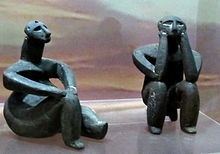
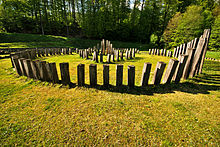


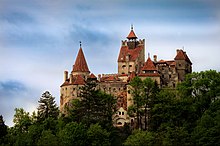

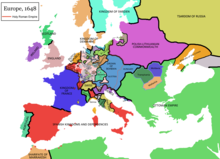


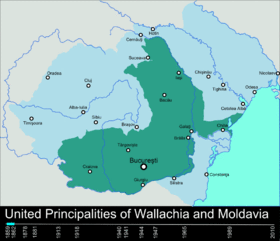





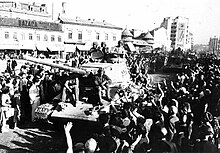


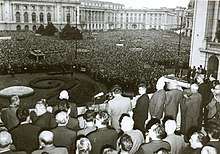


No comments:
Post a Comment